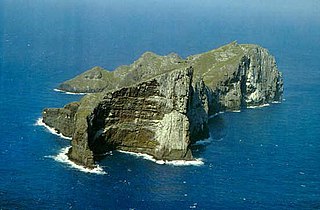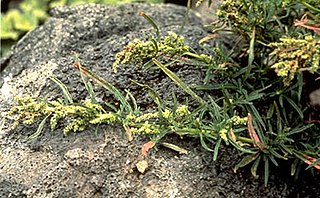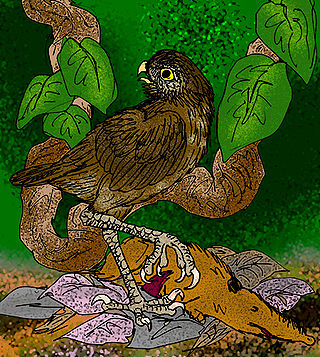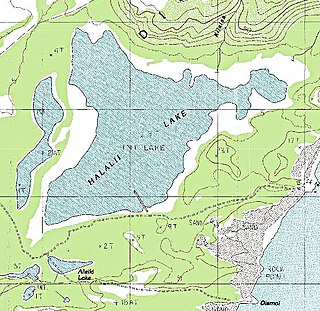
Owls are birds from the order Strigiformes, which includes over 200 species of mostly solitary and nocturnal birds of prey typified by an upright stance, a large, broad head, binocular vision, binaural hearing, sharp talons, and feathers adapted for silent flight. Exceptions include the diurnal northern hawk-owl and the gregarious burrowing owl.

The true owls or typical owls are one of the two generally accepted families of owls, the other being the barn owls (Tytonidae). This large family comprises 230 living or recently extinct species in 24 genera. The typical owls have a cosmopolitan distribution and are found on every continent except Antarctica.

Nihoa, also known as Bird Island or Moku Manu, is the tallest of ten islands and atolls in the uninhabited Northwestern Hawaiian Islands (NWHI). The island is located at the southern end of the NWHI chain, 296 km (160 nmi) southeast of Necker Island. Nihoa is the closest NWHI in proximity to the eight main windward Hawaiian Islands at approximately 240 km (130 nmi) northwest of the island of Kauaʻi. The island has two peaks, 272 m (892 ft) Miller's Peak in the west, and 259 m (850 ft) Tanager Peak in the east. Nihoa's area is about 171 acres (0.69 km2) and is surrounded by a 142,000-acre (57,000 ha) coral reef. Its jagged outline gives the island its name, Nīhoa, which is Hawaiian for "toothed, serrated".

The laughing owl, also known as whēkau, the jackass, or the white-faced owl, is an extinct species of owl that was endemic to New Zealand. Plentiful when European settlers arrived in New Zealand, its scientific description was published in 1845, but it was largely or completely extinct by 1914. The species was traditionally considered to belong to the monotypic genus Sceloglaux Kaup, 1848, although recent genetic studies indicate that it belongs with the boobook owls in the genus Ninox.

The Kauaʻi ʻōʻō or ʻōʻōʻāʻā was the last member of the ʻōʻō (Moho) genus within the Mohoidae family of birds from the islands of Hawaiʻi. The entire family is now extinct. It was previously regarded as a member of the Australo-Pacific honeyeaters.
The Réunion scops owl, also known as the Réunion owl or Réunion lizard owl, was a small owl that occurred on the Mascarene island of Réunion, but became extinct before any living birds were described; it is only known from subfossil bones. One of the three Mascarene owls, it was formerly classified in the genus Mascarenotus, and most likely was similar to a long-eared owl in size and appearance, but with nearly naked legs. However, according to recent studies, it and its relatives belong to the genus Otus, and is likely descended from the Otus sunia lineage.
Māhāʻulepū Beach is a beach on the southeast coast of the Hawaiian island of Kauai. It is two miles (3.2 km) long and goes from Punahoa point to Paʻoʻo point. The beach is separated into three different parts: Gillin's Beach, Kawailoa Bay, and Hāʻula Beach. Gillin's Beach, the center section, is known for petroglyphs that are carved into the rocks, though they are rarely exposed. Fossils of extinct birds have been found in sand dunes along the shoreline, including the Kauaʻi Stilt-owl, a flightless rail, and three species of goose. Close to the beach is the paleontologically important Makauwahi Cave.

Amaranthus brownii was an annual herb in the family Amaranthaceae. The plant was found only on the small island of Nihoa in the Northwestern Hawaiian Islands, growing on rocky outcrops at altitudes of 120–215 m (394–705 ft). It was one of nine species of Amaranthus in the Hawaiian Islands, as well as the only endemic Hawaiian species of the genus. It is now considered extinct.

The giant Cuban owl or giant cursorial owl (Ornimegalonyx) is an extinct genus of giant owl that measured 1.1 metres in height. It is closely related to the many species of living owls of the genus Strix. It was a flightless or nearly flightless bird and it is believed to be the largest owl that ever existed. It lived on the island of Cuba.

The Mascarene owls, also known as Mascarene scops owls or lizard owls, are a group of owls formerly classified in their own genus Mascarenotus, but now thought to represent a polyphyletic grouping within the genus Otus. They were restricted to the Mascarene Islands in the Indian Ocean. All three species, the Réunion scops owl, Mauritius scops owl, and Rodrigues scops owl, are now extinct.

The pueo is a subspecies of the short-eared owl and is endemic to Hawaii. The pueo is one of the more famous of the various physical forms assumed by ʻaumākua in Hawaiian culture.
Storrs Lovejoy Olson was an American biologist and ornithologist who spent his career at the Smithsonian Institution, retiring in 2008. One of the world's foremost avian paleontologists, he was best known for his studies of fossil and subfossil birds on islands such as Ascension, St. Helena and Hawaii. His early higher education took place at Florida State University in 1966, where he obtained a B.A. in biology, and the University of Florida, where he received an M.S. in biology. Olson's doctoral studies took place at Johns Hopkins University, in what was then the School of Hygiene and Public Health. He was married to fellow paleornithologist Helen F. James.

The great Maui crake or great Maui rail is an extinct bird species from Maui, Hawaiian Islands, known only from subfossil bones. The holotype are the bones of one almost-complete skeleton, found in Auwahi Cave on the lower southern slope of Haleakalā at 1,145 m AMSL. Its first remains, however, were recovered in 1972 and/or 1974 from lower Waihoi Valley further east and less than half as far uphill.
The wood harrier or mime harrier is an extinct bird of prey which lived in Hawaii during the Holocene. This small, short-winged harrier inhabited the forests of Molokai and Oahu where it presumably hunted for small birds and insects.
Xestospiza fastigialis is an extinct species of bird with a ridge-shape bill that was described on the basis of fossils. It was possibly an insectivore, populating the Hawaiian Islands of Oahu, Molokai and Maui.
Xestospiza conica is an extinct species of bird with a cone-shaped bill that was described on the basis of fossils. It was possibly an insectivore, populating the Hawaiian Island of Kauai.

The Hawaiian hawk or ʻio is a raptor in the genus Buteo endemic to Hawaiʻi, currently restricted to the Big Island. The ʻio is one of two extant birds of prey that are native to Hawaiʻi, the other being the pueo and fossil evidence indicates that it inhabited the island of Hawaiʻi, Molokaʻi, Oʻahu, Maui and Kauaʻi at one time. Today, it is known to breed only on the Big Island, in stands of native ʻōhiʻa lehua trees. The species was protected as an endangered species in the United States, but was delisted in 2020. However, the IUCN classifies the species as Near Threatened. NatureServe considers the species Vulnerable.

Hālaliʻi Lake is an ephemeral lake in the south central region of the island of Niʻihau. During the rainy seasons, it becomes the largest lake in the Hawaiian Islands. It is located near the smaller Halulu Lake, regarded as the largest (non-intermittent) natural lake in the Hawaiian Islands.

Halulu Lake is a lake in the south central region of the island of Niʻihau. It is the largest (non-intermittent) natural lake in the Hawaiian Islands and ranks third in size after Hālaliʻi Lake and Keālia Pond which are intermittent bodies of water.













